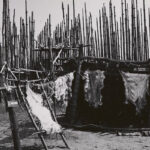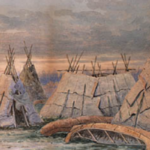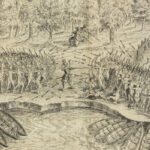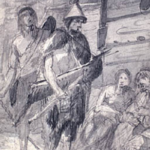The Madawaska Maliseet First Nation: Guardians of the Upper Saint John River Valley
The Madawaska Maliseet First Nation, located in northwestern New Brunswick along the upper Saint John River, holds a significant place in the history of the Maliseet (Wolastoqiyik) people. Known as the “People of the Beautiful River”, the Wolastoqiyik have a deep connection to the waterways that shaped their culture, economy, and way of life. For the Madawaska Maliseet, their story spans thousands of years, encompassing their pre-contact traditions, early encounters with European settlers, and their continued resilience and adaptation in the face of change.
Pre-History: Wolastoqiyik and the Madawaska Region
The ancestors of the Madawaska Maliseet First Nation have lived in the Wolastoq (Saint John River) Valley for over 10,000 years, their presence reflected in archaeological evidence such as ancient tools, pottery fragments, and fishing weirs. The Madawaska region, at the confluence of rivers and nestled within a rich and diverse ecosystem, was particularly well-suited for the Wolastoqiyik way of life.
Seasonal cycles dictated their movements. Summers were spent along the rivers and lakes, where fishing for salmon, sturgeon, and eels was abundant, while winters brought smaller groups inland to hunt moose, caribou, and smaller game. Their knowledge of the land and its rhythms ensured a sustainable use of resources, guided by the principle of Netukulimk, which emphasized balance and taking only what was necessary for survival.
The name Madawaska itself, derived from the Maliseet word “Madaweskek,” meaning “Land of Porcupines,” reflects the deep connection between the people and their environment. The land, its flora, and fauna were not only essential for sustenance but also imbued with spiritual significance, forming the foundation of their worldview.
Governance and Social Structure
The Wolastoqiyik, including those of Madawaska, maintained a decentralized and cooperative governance system. Communities were led by Sakomak (chiefs), who made decisions in consultation with elders and other respected members of the community. These leaders were chosen for their wisdom, hunting skills, and ability to mediate disputes, reflecting the Wolastoqiyik’s emphasis on collective well-being and unity.
Kinship bonds played a central role in social organization, with extended families providing support and ensuring the transmission of cultural knowledge. Oral traditions preserved the history, spiritual teachings, and practical skills of the community, ensuring that each generation was deeply connected to its heritage.
First Contact with Europeans
The arrival of European explorers and settlers in the 16th century brought profound changes to the Wolastoqiyik of Madawaska. Early interactions with French explorers, such as Samuel de Champlain, were largely characterized by trade. The Wolastoqiyik, who were skilled navigators and traders, provided furs—especially beaver pelts—in exchange for European goods like metal tools, cloth, and firearms.
The fur trade became a central aspect of these relationships, with the Madawaska region serving as a critical hub due to its strategic location along key waterways. While the trade introduced new opportunities, it also disrupted traditional economies and led to the overharvesting of fur-bearing animals. Additionally, the arrival of Europeans brought devastating epidemics, such as smallpox and measles, which significantly reduced the population.
Relationships with French Missionaries and Settlers
In the 17th century, French missionaries, particularly the Jesuits, sought to convert the Wolastoqiyik to Christianity. The establishment of missions along the Saint John River, including in the Madawaska region, introduced new religious practices and education systems. Many Wolastoqiyik integrated aspects of Christianity into their traditional beliefs, blending the two into a syncretic spiritual practice that reflected their adaptability.
The Wolastoqiyik, including the Madawaska Maliseet, also formed alliances with the French during periods of conflict, such as the Seven Years’ War (1756–1763). These alliances were based on mutual benefits: the French relied on the Wolastoqiyik for their knowledge of the land and waterways, while the Wolastoqiyik gained access to trade goods and military support.
British Expansion and Its Impact
The British victory in 1763 marked a turning point for the Wolastoqiyik. British policies often ignored Indigenous sovereignty, leading to increased encroachment on traditional lands. The Proclamation of 1763, which aimed to protect Indigenous territories, was inconsistently enforced, and settlers began to occupy key areas, including the Madawaska region.
The establishment of reserves under the Indian Act (1876) further restricted the autonomy of the Madawaska Maliseet. Confined to smaller portions of their ancestral lands, the community faced significant challenges in maintaining their traditional way of life. Despite these pressures, they adapted by incorporating new economic activities, such as logging and farming, while continuing to fish, hunt, and gather.
The 19th and 20th Centuries: Resilience Amidst Change
During the 19th century, the Madawaska Maliseet increasingly engaged with the logging industry, which grew along the Saint John River and its tributaries. Their skills as canoe builders, navigators, and woodsmen made them invaluable participants in this burgeoning economy. However, the loss of traditional lands and the imposition of colonial governance continued to pose challenges.
The community faced further cultural disruptions during the era of residential schools, which sought to assimilate Indigenous children by severing their ties to their language and heritage. Despite these efforts, the Madawaska Maliseet preserved many aspects of their culture through oral traditions, seasonal gatherings, and the enduring connection to their land and river.
Cultural Revitalization and Language Preservation
In recent decades, the Madawaska Maliseet First Nation has undertaken significant efforts to preserve and revitalize their culture. The Wolastoqey language, once at risk of being lost, is now the focus of community-led initiatives, including language immersion programs and cultural workshops. These efforts ensure that younger generations remain connected to their heritage.
Seasonal activities, such as salmon fishing and traditional crafts like basket-making and beadwork, are celebrated as integral parts of Madawaska’s identity. The annual Madawaska Powwow, featuring drumming, dancing, and storytelling, serves as both a cultural celebration and a means of fostering unity within the community.
Environmental Stewardship and Modern Advocacy
The Madawaska Maliseet have long been stewards of the land and waterways that sustain them. Their traditional ecological knowledge, passed down through generations, informs their approach to resource management and environmental advocacy. The community has taken an active role in addressing issues such as water quality, habitat restoration, and sustainable development.
The restoration of salmon populations in the Saint John River, once a vital resource for the Wolastoqiyik, has been a central focus of their environmental efforts. Partnerships with governments and environmental organizations reflect their commitment to preserving their lands and waterways for future generations.
Madawaska Today: A Thriving Community
Today, the Madawaska Maliseet First Nation is a vibrant and dynamic community that balances economic development with cultural preservation. Investments in infrastructure, healthcare, and education reflect their commitment to building a sustainable future. The community has also embraced economic opportunities in industries such as tourism, renewable energy, and small business development, showcasing their adaptability and entrepreneurial spirit.
The Madawaska Maliseet remain leaders in cultural preservation, using modern tools and platforms to celebrate their heritage and educate others about their history. Their resilience and determination serve as a powerful example of how Indigenous communities can thrive while honouring their traditions.
Conclusion: A Legacy of Strength and Continuity
The history of the Madawaska Maliseet First Nation is a testament to their resilience, adaptability, and deep connection to the land and waterways of the Saint John River Valley. From their ancient presence in the region to their central role in early European trade and their modern efforts in cultural revitalization and environmental advocacy, the Madawaska Maliseet have maintained their identity and place within Canada’s evolving landscape.
As an elder from Madawaska once said, “The river is not just water—it is life, memory, and the heart of our people. By protecting it and our traditions, we honour the past and ensure our future.”
References
- Hickerson, Harold. The Algonquian Peoples of the Boreal Forest. McGill-Queen’s University Press, 1973.
- Jesuit Relations. Documents of the Missions to New France. McGill University Press, 1962.
- Conrad, Margaret. A Concise History of Canada. Cambridge University Press, 2012.
- Environmental Justice Advocacy Group. Stewardship and Sovereignty: The Role of the Wolastoqiyik in Environmental Advocacy. University of Guelph Press, 2019.
- Madawaska Cultural Centre. Guardians of the Upper River: The History and Culture of Madawaska Maliseet First Nation. Madawaska Publications, 2015.
- Ridington, Robin. Trail to Heaven: Knowledge and Narrative in a Northern Native Community. Douglas & McIntyre, 1988.
- Johnston, Basil. Ojibway Heritage. McClelland & Stewart, 1976.
- Snow, Dean R. The Iroquois. Blackwell, 1994.
- Neeposh, Thomas. “Protecting Our Future: The Vision of Madawaska First Nation.” CBC News, 2021.
- Whitehead, Ruth Holmes. The Old Man Told Us: Excerpts from Micmac History, 1500–1950. Nimbus Publishing, 1991.



